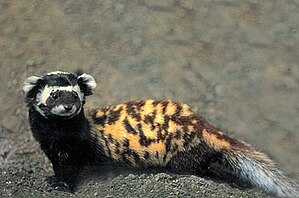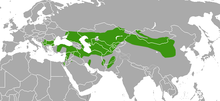Marbled polecat
| Marbled polecat | |
|---|---|

| |
| Adult marbled polecat (Vormela peregusna) | |
| Scientific classification | |
| Kingdom: | |
| Phylum: | |
| Class: | |
| Order: | |
| Family: | |
| Subfamily: | |
| Genus: | Vormela
|
| Species: | V. peregusna
|
| Binomial name | |
| Vormela peregusna (Güldenstädt, 1770)
| |

| |
| Marbled polecat range | |
The marbled polecat (V. peregusna) is a small mammal belonging to the monotypic genus Vormela within the Mustelinae subfamily. Vormela is from the German word Würmlein,[1] which means "little Worm". The term peregusna comes from pereguznya, which is Ukrainian for polecat.[2] Marbled polecats are generally found in the dryer areas and grasslands of south-eastern Europe to western China. Like other members of Mustelinae, it can emit a strong smelling secretion from anal sacs under the tail when threatened.
Description


Ranging in length from 29–35 cm (head and body), the marbled polecat has a short muzzle and very large, noticeable ears. Limbs are short and claws are long and strong. While the tail is long, with long hair, overall pelage is short. Black and white marks the face, with a black stripe across the eyes and white markings around the mouth. Dorsally, pelage is yellow and heavily mottled with irregular reddish or brown spots. Tail is dark brown with a yellowish band in the mid-region. The ventral region and limbs are a dark brown.[3] Female mass ranges from 295g up to 600g and males can range from 320g to 715g.[4][5][6]
Distribution
The marbled polecat is found from south-east Europe to Russia and China. Range includes Bulgaria, Georgia, Turkey, Romania, Asia Minor, Lebanon, Syria, Jordan, Israel, Palestine, Armenia, Iran, Afghanistan, north-western Pakistan, Yugoslavia, Mongolia, China, Kazakhstan and north to the Altai Steppes in Siberia.[7][8][9][10][11][12][13][14][15][16] In 1998, a marbled polecat was recorded on the Sinai Peninsula, Egypt.[17]
Behavior
Marbled polecats are most active during the morning and evening.[18][19][20] Their eyesight is weak and they rely on a well-developed sense of smell.[21] Vocalization is limited and consists of shrill alarm cries, grunts and a submissive long shriek.[22]
Marbled polecats are solitary and move extensively through their 0.5 to 0.6 km² home range. They generally only stay in a shelter once. When they encounter each other they are usually aggressive.[23]
When alarmed, marbled polecats raise up on their legs while arching their back and curling their tail over their back with long tail hair erect. They also raise their head, bare their teeth and give shrill, short hisses.[24][25] If threatened, they can expel a foul-smelling secretion from enlarged anal glands under their tail.[26]
To dig, such as when they are excavating dens, marbled polecats dig out earth with their forelegs while anchoring themselves with their chin and hind legs. They will use their teeth to pull out obstacles such as roots.[27]
Reproduction
Marbled polecats mate during March to early June.[28][29] Gestation can be long and variable (243 days to 327 days).[30] Parturition has been observed to occur from late January to mid-March.[31][32] Delayed implantation allows marbled polecats to time the birth of their cubs for favorable conditions, such as when prey is abundant.[33]
Litter size ranges from 4–8 cubs.[34][35][36] Only females care for the young. Cubs open their eyes at around 38–40 days, are weaned at 50–54 days and leave their mother (disperse) at 61–68 days.[37]
Ecology
Habitat
Marbled polecats are found in open desert, semi-desert, semi-arid rocky areas in upland valleys and low hill ranges, steppe country and arid subtropical scrub forest. They avoid mountainous regions.[38][39][40] Marbled polecats have been sighted in cultivated areas such as melon patches and vegetable fields.[41]
Burrows of large ground squirrels or similar rodents such as the great gerbil (Rhombomys opinus) and Libyan jird are used by marbled polecats for resting and breeding. They may also dig their own dens or live in underground irrigation tunnels.[42][43] In the winter, marbled polecats will line their den with grass.[44]
Diet
Marbled polecats are known to eat ground squirrels, Libyan jirds (Meriones libycus), Armenian hamsters (Cricetulus migratorius), voles, mole rats (Spalax lecocon ehrenbergi), house mice (Mus musculus), and other rodents, small hares, birds, lizards, fish, frogs, insects (e.g. snails, beetles, crickets) as well as fruit and grass.[45][46][47][48][49] They are also recorded as taking small domestic poultry such as chickens and pigeons as well as stealing smoked meat and cheese.[50][51][52]
Conservation status
In 2008, V. peregusna was classified as a vulnerable species in the IUCN Red List of Threatened Species due to a population reduction of at least 30% in the previous 10 years.[53] In 1996, it had been considered a species of least concern. It is thought that decline in marbled polecat populations may be due to habitat destruction (cultivation), rodenticide and reduction in available prey.[54][55][56]
Remarks
The marbled polecat had once been sought for its fur; also known as fitch in the fur trade.
In 1945 it was recorded that Kabul shopkeepers kept marbled polecats to exterminate rodents.[57]
Other names for the marbled polecat include aladzhauzen (Turkmen); berguznya (Kuban); chokha (Kalmuck); fessyah (stinky in Arabic); abulfiss (Arabic); hu-yio ( tiger (-striped) yio Chinese); myshovka (Terek cossak dialect); pereguznya, pereguzka, perevishchik (Ukrainian); perevyazka (Russian]); perewiaske (Polish); Benekli kokarca Turkish ; suur-tyshkan (Kyrgyz); putois marbré, putois de Pologne (French); Tigeriltis (German); mottled polecat; sarmatier; Syrian marbled polecat and tiger polecat.[58]
There are several subspecies of V. peregusna, including:
- V. p. alpherakyi
- V. p. euxina
- V. p. negans
- V. p. pallidor
- V. p. peregusna
- V. p. syriaca
See also
References
- ^ Akhtar, S. A. (1945). "On the habits of the marbled polecat, Vormela peregusna". Journal of Bombay Natural History Society. 45: 142.
- ^ Bodenheimer, F.S. (1935). Animal life in Palestine: an introduction to the problems of animal ecology and zoogeography. Jerusalem, Israel: L. Mayer.
- ^ Ben-David, M. (1988). The biology and ecology of the Marbled polecat, Vormela peregusna syriaca, in Israel. Israel: Tel-Aviv University.
- ^ Ben-David, M. (1998). "Delayed implantation in the marbled polecat, Vormela peregusna syriaca (Carnivora, Mustelidae): evidence from mating, parturition, and post-natal growth". Mammalia. 62 (2): 269–283. doi:10.1515/mamm.1998.62.2.269.
- ^ Gorsuch, W.; Larivière, Serge (2005). "Vormela peregusna". Mammalian Species. 779: 1–5. doi:10.1644/779.1.
- ^ Harrison, D. (1968). Mammals of Arabia Volume 2. London: Ernest Benn Limited.
- ^ Kryštufek, B. "Mustelids in the Balkans – small carnivores in the European biodiversity hot-spot.". In H. J. Griffiths (ed.). Mustelids in a modern world: management and conservation aspects of small carnivore and human interactions. Leiden, Netherlands: Backhuys Publishers. pp. 281–294.
{{cite book}}: Cite has empty unknown parameters:|origmonth=,|month=,|chapterurl=,|origdate=, and|coauthors=(help) - ^ Lewis, R. E., J. H. Lewis, and S. I. Atalla (1968). "A review of Lebanese mammals: Carnivora, Pinnipedia, Hyracoidea, and Artiodactyla". Journal of Zoology London. 154 (4): 517–531. doi:10.1111/j.1469-7998.1968.tb01683.x.
{{cite journal}}: CS1 maint: multiple names: authors list (link) - ^ MacDonald, D. (1993). Mammals of Britain and Europe. New York: Harper Collins Publishers. ISBN 0002197790.
{{cite book}}: Unknown parameter|coauthors=ignored (|author=suggested) (help) - ^ Milenković. "The marbled polecat, Vormela peregusna (Güldenstaedt 1770) in FR Yugoslavia and elsewhere". In H. J. Griffiths (ed.). Mustelids in a modern world: management and conservation aspects of small carnivore and human interactions. Leiden, Netherlands: Backhuys Publishers. pp. 321–329.
{{cite book}}: Cite has empty unknown parameters:|origmonth=,|month=,|chapterurl=,|M. authorlink=, and|origdate=(help); Unknown parameter|coauthors=ignored (|author=suggested) (help) - ^ Novikov, G.A. (1962). Carnivorous mammals of the fauna of the USSR. Jerusalem: Israeli Program of Scientific Translation,. ISBN 0706501691.
{{cite book}}: CS1 maint: extra punctuation (link) - ^ Özkurt, Ş., M. Sözen, N. Yiğit, and E. Çolak (1999). "A Study on Vormela peregusna Guldenstaedt, 1770 (Mammalia: Carnivora) in Turkey" (PDF). Turkish Journal of Zoology. 23: 141–144.
{{cite journal}}: CS1 maint: multiple names: authors list (link) - ^ Qumsiyeh, M. B., Z. S. Amr, and D. M. Shafei (1993). "Status and conservation of carnivores in Jordan". Mammalia. 57: 55–62. doi:10.1515/mamm.1993.57.1.55.
{{cite journal}}: CS1 maint: multiple names: authors list (link) - ^ Rifai, L. B., D. M. Al Shafee, W. N. Al Melhim, and Z. S. Amr (1999). "Status of the marbled polecat, Vormela peregusna (Gueldenstaedt, 1770) in Jordan". Zoology in the Middle East. 17: 5–8.
{{cite journal}}: CS1 maint: multiple names: authors list (link) - ^ Roberts, T.J. (1977). The mammals of Pakistan. England: Ernest Benn Limited. ISBN 0195795687.
- ^ Saleh, M. A., and M. Basuony (1998). "A contribution to the mammalogy of the Sinai Peninsula". Mammalia. 62 (4): 557–575. doi:10.1515/mamm.1998.62.4.557.
{{cite journal}}: CS1 maint: multiple names: authors list (link) - ^ Schreiber, A. (1989). Weasels, civets, mongooses and their relatives: an action plan for the conservation of mustelids and viverrids. Broadview, Illinois: Kelvyn Press, Inc.
{{cite book}}: Unknown parameter|coauthors=ignored (|author=suggested) (help) - ^ Stroganov, S.U. (1969). Carnivorous mammals of Siberia. Jerusalem, Israel: Israeli Program of Scientific Translation. ISBN 0706506456.
- ^ Tikhonov, A., Cavallini, P., Maran, T., Krantz, A., Herrero, J., Giannatos, G., Stubbe, M., Conroy, J., Kryštufek, B., Abramov, A. & Wozencraft, C. 2008. Vormela peregusna. In: IUCN 2010. IUCN Red List of Threatened Species. Version 2010.4. www.iucnredlist.org. Downloaded on 16 February 2011.

